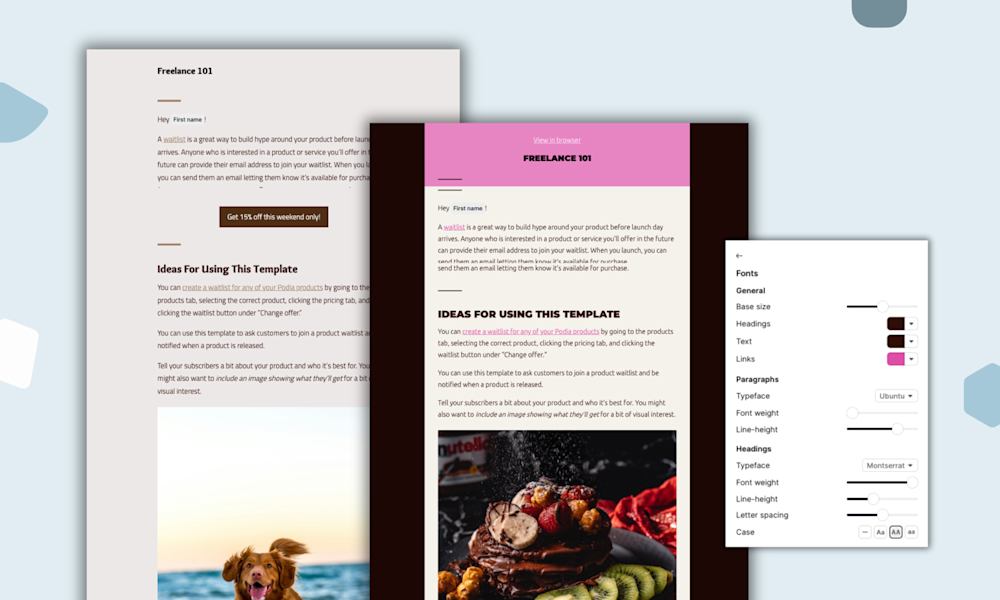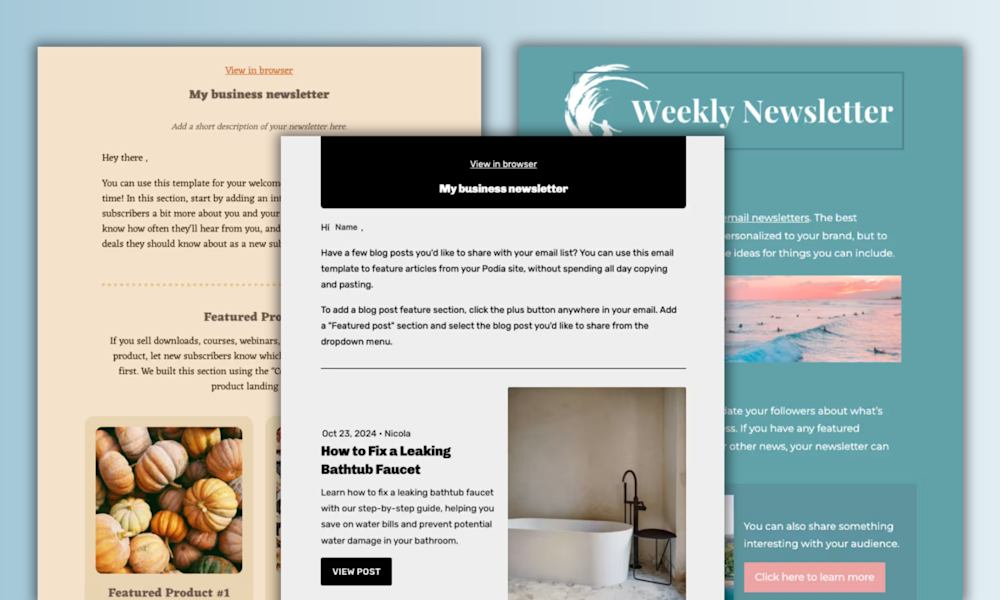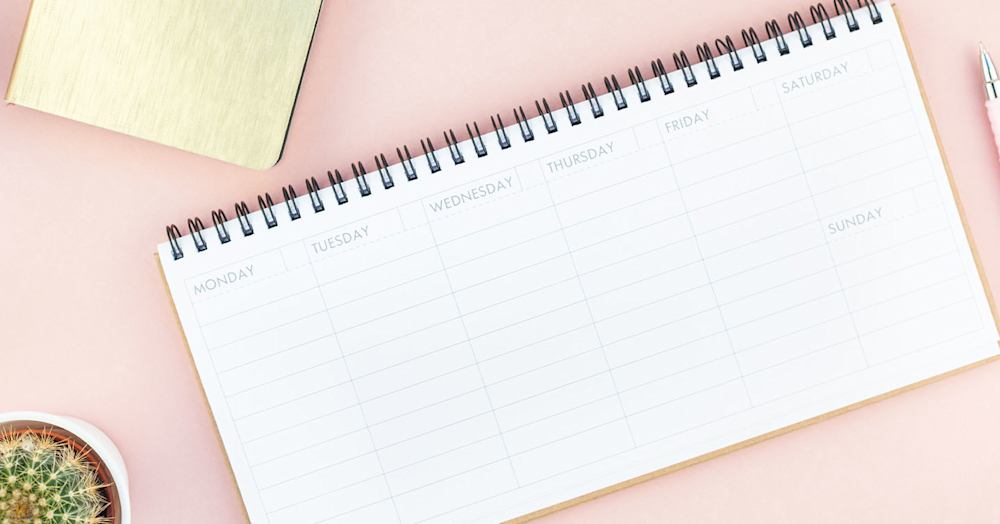Successful small businesses have one secret in common: they harness the power of the newsletter.
You might have heard that email newsletters are dead, but that’s far from true.
With engagement rates that beat every social media platform out there, newsletters have never been more alive. Indeed, emails are 40 times better at acquiring new customers than Facebook or Twitter.
So what’s stopping you from creating one?
In this article, we’ve chosen 18 of the best email newsletter examples. From gorgeous designs to beautiful prose, one of these will inspire you to make your own.
1. Ann Handley

Total Annarchy by marketing guru Ann Handley is one of the finest examples of long-form emails out there. With a focus on “letter” more than “news”, each biweekly newsletter is full of useful writing or marketing strategy advice. Aside from the header, it’s purely text-based.

Each letter feels personal, as if Ann is writing just to you. She keeps promotional posts, news, and other links out of the way at the bottom of the email.
Her email subject lines are rule-breaking. They’re longer than what most marketers would recommend and include emoji. Some schools of marketing think emoji lead to a lower open rate. But they work for her, regardless.

The takeaway is that rules are made to be broken — especially if your writing is a hit with your subscribers. Don’t be afraid to experiment.
2. Alexandra Franzen

Flush with 13,000 subscribers, Alexandra Franzen’s newsletter is another classic of the text-based genre.
A lot of the newsletter advice you get is that it a) should stick to a schedule and b) have consistent content.
Alexandra does neither of these things.
Her newsletters are “weekly-ish” — some weeks, you’ll get two emails from her, others, none.
And content-wise, she breaks the consistency rules too. Alexandra alternates between sending high-quality essays to lists of resources and playlists.
But it absolutely resonates with her readers.

If being consistent is stopping you from creating a newsletter, then take heart from Alexandra’s example. Of course, her approach works because her emails are all aimed at the same audience.
So if you share dog training advice in one email and an essay on stamp collecting in the next, it’s unlikely to have the same success rate.
The litmus for experimenting or breaking “the rules” is that the content stays relevant. As long as it’s relevant, you can play around with its format and frequency.
3. Dave Gerhardt

Marketing expert Dave Gerhardt runs a must-read weekly newsletter. He covers all things B2B (business-to-business) digital marketing.
Dave keeps things brief in his emails. They’re purely text-based and categorized: Thursday Thought, Content Corner, Job Alerts, and End of Week Wisdom. The variety makes it appealing to marketers at different stages of their careers.
Dave’s intro is also a great example of how to encourage signups.

Having a pre-written tweet is particularly inspired, as it makes it easy for people to support you. See exhibit A below.

Having a structure for both writing and promoting your emails can make it easier to do both. After all, you just need to fill in the blanks, which should save you valuable time.
4. Ben Toalson

Email by email, you can demystify a big topic for your subscribers.
That’s exactly what Ben Toalson, Podia’s Video Content Marketer, does with his newsletter content. Making videos might feel a bit daunting, but with Ben’s top-shelf advice, you can breathe a little easier.
Built in Podia, his emails are primarily text-based. Images are thoughtfully deployed to illustrate his trial and error.

Half-essay, half-instruction manual, Ben explains what he tested and what failed, before leaving the reader with some inspiring lessons learned.

Like Ben, you could use your newsletter as an opportunity to share your expertise in a relatable way. Humans relate to humans, so don’t be afraid to share your errors as well as your successes.
5. NextDraft

Dave Pell’s newsletter NextDraft is a curation of his favorite weird and fascinating news.
There are plenty of valuable newsletters out there. What makes NextDraft stand out is that it’s hand-curated. It’s a bit like your friend forwarding their favorite news snippets to you with a handwritten note attached.

Dave’s newsletter is no mean feat: he sends the newsletter out daily, and each item he shares is substantial. What makes this special rather than annoying is his take on the news: it’s witty and irreverent, making you want to see the world through his eyes.
6. Austin Kleon

Austin Kleon, the author of Steal like an artist, runs a weekly newsletter. It’s a top 10 list of his favorite things from that week, be it art, writing, or news.
Each item is kept short — it’s easy to skim them and find what holds your interest.

A simple concept with a significant impact, Austin currently has an 85,000 strong email list and counting.
Austin’s newsletter just goes to show that you don’t need an elaborate concept for your newsletter. Sharing your ten favorite things of the week can be as powerful as writing soul-searching essays — good news for everyone who loves a listicle.
7. Energy Medicine Yoga

Startups can also create impactful newsletters, as Energy Medicine Yoga proves. Their newsletter works because it avoids over-selling. Instead, it’s dreamy and inspiring with passages like this.

Business newsletters can be tricky to get right, but Energy Medicine Yoga is able to keep their content relaxed.
8. Animalz

Another marketing newsletter? Yes, but this one’s a good one from content marketing company Animalz.
Their newsletters are clever, personable, and packed full of insights. Take, for instance, this introduction to one of their newsletters.

Despite being a business newsletter, the tone stays personal and light, making it much more likable. And therefore, you’re much more likely to keep reading.
9. Glitch

If only all tech updates came in as gorgeous a package as this.
Glitch’s illustrated and pink-hued email stands out for all the right reasons. With plenty of white space, you can read the email content at a glance. There’s also one clear CTA button (call-to-action), asking readers to upgrade.

If you feel intimidated about their illustrations, we’ve written a guide to help you design your own graphics without design skills.
10. AfterShokz

Headphone creators Aftershokz created a striking black and white newsletter.
Monochrome is a simple yet effective way of a cohesive visual impact. It’s been found to help the reader focus on the content and messaging. In this case, it makes it easier for the photo to blend into the background.
The result is that their messaging looks like an editorial advert rather than a traditional newsletter.
11. Tigers Are Better Looking

You don’t need to spend buckets of dollars to create an eye-catching newsletter. Sometimes all it takes is the right splash of paint.
Lifestyle and culture newsletter Tigers Are Better Looking wields color simply yet effectively. They use a standard Mailchimp newsletter template. But their logo and color-blocking elevate the whole look.

Simple can be effective. The right dash of color can tie your whole look together. Color psychology suggests you should restrict yourself to three colors maximum: main, complementary, and an accent color.
Tigers choose their colors from their logo and their pink background, with all their boxes colored from one or the other.
12. The Newsette

GIFs and newsletters: a match made in heaven, or a recipe for slow loading times?
Both. Use them only if they’re relevant, and keep their size small using a tool like Ezgif to optimize them.
For example, here’s The Newsette’s welcome email with a GIF. The email would read fine without it, but it also adds a layer of fun and fits in with their website branding, which is animated.

Watch this video to learn how to make GIFs and other graphics without Photoshop.
13. Harry’s

Shaving company Harry’s has developed a reputation for unique and quirky newsletters. They often use illustrations rather than photography, which is unusual for an ecommerce site.
Harry’s is also leading the charge of a new trend of comic-strip style, or illustrative infographic, newsletters. This approach is ideal for instructions or for helping your readers project themselves into a situation.
Below they use it to demonstrate how to use their new product in a few steps.

You don’t need drawing skills to create an illustrative newsletter like the above. Canva’s templates can help you do just that.
14. Peloton

Who doesn’t love an email made just for you? Personalized email messages improve click-through rates by 14% and conversions by 10%.
For a long time, personalization has been associated with having your first name at the top of your email. But things have evolved, and now it can go much further.
Take Peloton, for instance, who sends “your month in review” messages with your stats, in addition to the above example of personalized encouragement. It’s practical, and it’s motivating, as it gives you a benchmark for your workouts.

15. MicroQuiz

As the name suggests, Tris J Burns’ MicroQuiz newsletter revolves around a quiz. Every week, he asks a quick poll question and shares the results the following week.

It’s simple but effective. And, after just four months in existence, Tris has seen his new subscriber rates grow, along with engagement rates.

A quiz or survey, especially when it’s quick and easy to answer, can be irresistible to your readers when it’s for fun.
It has even more impact if it helps them make a big decision, like in the example below.
16. GoDaddy

GoDaddy’s campaign to help subscribers find their ideal site builder was highly successful, with an open rate of 58%.
The topic of choosing a sales page builder can be a daunting one for many folks. GoDaddy’s guided quiz breaks the process down and makes it easier to understand.
17. Penguin Random House

Penguin Random House encouraged click-throughs in their newsletter with this guessing game.
Subscribers were invited to guess book titles from a series of emoji. It’s the kind of puzzle many book-lovers would find difficult to resist.
Best of all, it’s not complicated to replicate a guessing game like this. Each image is simply hyperlinked to a book’s product page.
Interactive content can be entertaining, of course, but it can also be beneficial, as the next example proves.
18. Litmus

This email by Litmus uses animated elements to showcase its accessibility switcher. With just one click, you can increase the contrast or the size of the text.
They also included a fallback version for email clients that don’t support interactivity.

This way, they can showcase the switcher in action. In both versions, they demonstrate their product in action, which will make readers more inclined to use it themselves.
Email newsletters have never been more alive
Newsletters are far from dead, as these email newsletter examples have proven.
Email newsletter ideas are a dime a dozen. Swing at a search engine blindly, and you’ll find a dozen posts just like this one, but what makes these examples different is that you can inspire yourselves from them.
With a few exceptions, their designs and approaches are easily replicable. What isn’t is your audience and your unique perspective on the subject matter.
So inspire yourself, but don’t be afraid to take another route either if it works best for you.
If a flexible newsletter format works for you, go for it. But if a structured format will help you create a newsletter more regularly, then have at it. The important thing to keep consistent is the relevancy to your audience.
Here are some further conclusions to draw:
-
You don’t need any images or elaborate designs to create a newsletter. Text-based newsletters are just as effective.
-
Newsletter design doesn’t necessarily involve Photoshop and design skills. Branded colors or a Canva-designed comic strip can help you stand out in your readers’ inbox.
-
Keep your readers entertained and engaged with interactive content. Subscribers love puzzles and quizzes.
Nothing can stop you now from building the newsletter of your dreams. You’ll be attracting and converting potential customers in no time at all.



